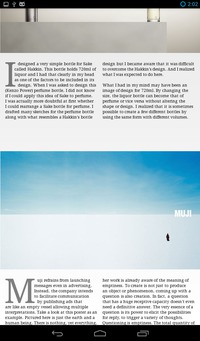 TypesetView is a
View that's great for displaying paragraphs of rag-right, static body
text in your Android app. It adds typographic niceties from more
sophisticated text layout engines, allowing refined control over your
content. Multicolumn text, TeX-style line breaks, margins that flow
around arbitrary shapes and more.
TypesetView is a
View that's great for displaying paragraphs of rag-right, static body
text in your Android app. It adds typographic niceties from more
sophisticated text layout engines, allowing refined control over your
content. Multicolumn text, TeX-style line breaks, margins that flow
around arbitrary shapes and more.
Multi-column text.

You can either directly set the number of columns, or just specify a minimum column width. If you set a minimum column width, TypesetView will automatically add columns based on the available width.
Flexible margins.

You can programatically control the margins for each line in the View. You can even write code to flow text around arbitrary paths, like around the large "O" glyph above.
Advanced linebreaks.
Unlike TextView, TypesetView wraps lines after examining a full paragraph of text. This allows it to minimize long gaps in a paragraph of rag-right text, if possible. Here is a side-by-side comparison of TextView on the left, and TypesetView on the right.
 TypesetView has moved the word "of" from the first line down to the second line, which leaves a slightly bigger gap for the first line. However, this lets it avoid a much larger gap in the third line. Software typophiles - it minimizes the sum of the squares of the end-of-line gaps in text that's set rag-right. It uses a variation of the Knuth-Plass algorithm (used in TeX.) It doesn't hyphenate words, and the "badness" of a line is simply the square of the right-side gap. The last line is ignored in the calculations.
TypesetView has moved the word "of" from the first line down to the second line, which leaves a slightly bigger gap for the first line. However, this lets it avoid a much larger gap in the third line. Software typophiles - it minimizes the sum of the squares of the end-of-line gaps in text that's set rag-right. It uses a variation of the Knuth-Plass algorithm (used in TeX.) It doesn't hyphenate words, and the "badness" of a line is simply the square of the right-side gap. The last line is ignored in the calculations.
And lastly...
A few small, but handy typographic controls.

First, you can allow the expansion of inter-word spaces in controlled amounts, if you want to further minimize gaps at the ends of lines.
Second, you can set the typographic leading explicitly, rather than TextView's unintuitive spacing "multipliers" and "adders". If you want to set text at 16/18dp - you just set typeSize and typeLeading to 16dp and 18dp respectively.
Third, you can directly specify font families -- including fonts you
include under your assets/ folder -- directly from your XML.
Using TypesetView
Clone the TypesetView repository, and add typesetview-library
as a library project. To add a TypesetView within your layout, you
might do something like
<ScrollView
xmlns:android="http://schemas.android.com/apk/res/android"
xmlns:typeset="http://schemas.android.com/apk/res-auto"
android:layout_width="match_parent"
android:layout_height="wrap_content">
<org.kbsriram.android.typesetview.TypesetView
android:layout_width="match_parent"
android:layout_height="wrap_content"
typeset:typeColor="#ff303030"
typeset:typeSize="12sp"/>
</ScrollView>
Notice that you should use
http://schemas.android.com/apk/res-auto to refer to the
attributes that are specific to TypesetView.
Here are the TypesetView specific attributes you can specify.
typeText is a String, the text to display.
typeColor is a Color to use for the text.
typeFontFamily is a String, naming the font to use. There are
three pre-defined names, sans-serif, serif and
monospace, which will use the appropriate system provided
fonts. If you prefix the name with the magic string assets/
-- for example -- assets/Roboto-Slab.ttf -- it will look for
a font file at that location under your applications assets/
directory. In all other cases, it will ask the system to create the
font using the provided name.
typeSize is a dimension for the text size.
typeLeading is a dimension for the leading (ie. the distance
between baselines of text.
typeGutterWidth is a dimension for the space between columns
of text.
typeMaximumLineStretch is a dimension that controls the
maximum amount a line is permitted to expand. By default, it is equal
to the leading.
typeMaximumGlueExpansionRatio is a float and must be at least
1. Spaces between words are not allowed to expand larger than this
ratio. By default, it is 1.22
typeColumnWidth is a dimension. Specify this to set a minimum
column size, and TypesetView will automatically add columns as
needed. If you specify this, you cannot also specify
typeColumnCount.
typeColumnCount is an integer greater than 0. Specify this to
set exactly this many columns, regardless of the width of the view. If
you specify this, you cannot also specify typeColumnWidth.
You can programatically control margins by implementing the TypesetView.MarginPosition interface. Please look at the provided examples for further guidance on using this interface. Good luck and make great content!
Some images and text used within the examples are from the Nippon Design Center.